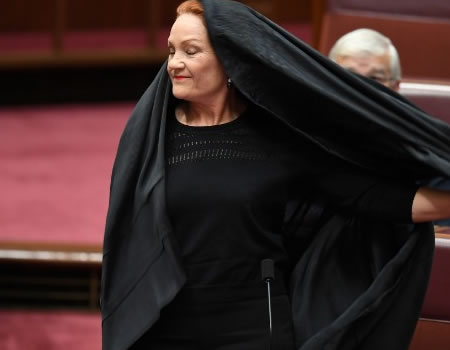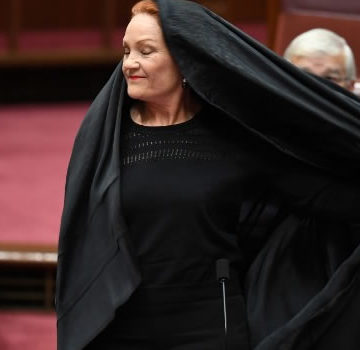In video of the parliamentary session, One Nation leader Pauline Hanson can be seen taking her seat in the floor-length Islamic garment. A voice on the recording can be heard saying, “What on Earth?”
Hanson has long called for the burqa to be banned in public, saying the central issue is the “right of others to see a face.”
Amid unrest from her fellow senators, Hanson dramatically took off the veil, saying “I’m quite happy to remove this because it’s not what should belong in this parliament.”
Hanson then asked Attorney General George Brandis, if “in light of what is happening with national security… will you work to ban the burqa?”
Brandis, a member of the governing Liberal National coalition, received a standing ovation when, close to tears, he tore into Hanson for mocking the Muslim dress.
“Senator Hanson, no, we will not be banning the burqa.”
“Senator Hanson, I’m not going to pretend to ignore the stunt that you have tried to pull today by arriving in the chamber dressed in a burqa, when we all know you are not an adherent of the Islamic faith.”
He told Hanson to be “very, very careful” of offending the “religious sensibilities of other Australians.”
“To ridicule that community, to drive it into a corner, to mock its religious garments is an appalling thing to do,” he said.
In a speech to Parliament, Hanson referred to terror threats as one reason for her proposed ban.
Australia’s terrorism threat level is currently listed as “probable,” on a four level scale between “possible” and “expected.”
Last month, Australian authorities thwarted alleged twin terror plots described as the “most sophisticated” ever planned on Australian soil. They included plans to release a toxic gas in public.
Since Australia’s national terrorism threat level was last raised in September 2014, there have been five attacks and 13 “major counter terrorism disruptions,” according to a representative for the Australian Security Intelligence Organization.
In her speech, Hanson cited an attack on the Iranian parliament building in June, by men believed to be dressed in burqas, as being one example of the security threat.
“This is not the first case of this kind and it will not be the last,” she said.







